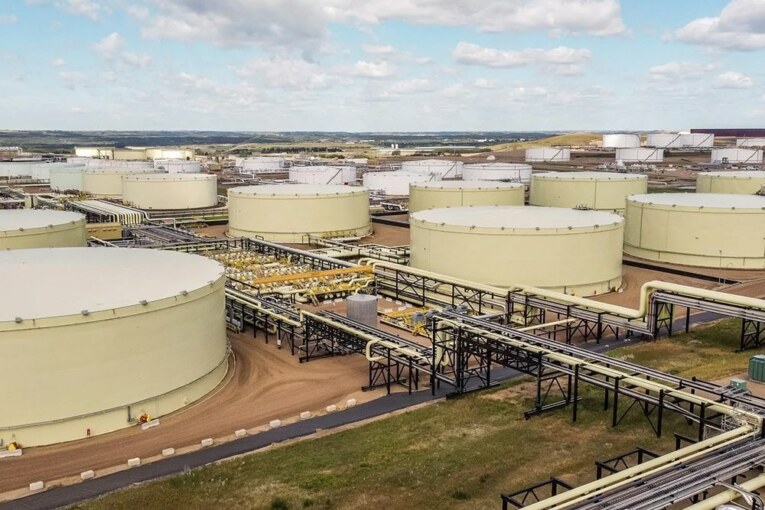
[ad_1]
After several years of scouting for new opportunities, Gibson Energy has made its move with the largest acquisition in the company’s 70-year history, one that gives it a big footprint in the United States.
The Calgary-based energy infrastructure company, which provides storage, processing and gathering of oil and refined products at its Hardisty and Edmonton terminals, announced a $1.5-billion agreement last week to buy the South Texas Gateway Terminal (STGT).
The cash deal includes an export terminal at Ingleside, Texas, at the mouth of Corpus Christi Bay. It will provide Gibson with one million barrels per day of permitted oil export capacity and almost nine million barrels of terminal storage.
“We’ve been looking to make an acquisition, a strategic acquisition, for the last four years…and across those four years, we didn’t find anything that actually, really fit,” Gibson Energy CEO Steve Spaulding said in an interview.
“This is a world-class asset. It’s in a strategically competitive position. It has excellent credit-worthy, large customers. And it’s fed by one of the most premier crude oil fields in the world right now, which is Permian Basin.”
The South Texas Gateway Terminal is one of only two facilities on the Texas Gulf Coast with deep-water docks that can load VLCCs (Very Large Crude Carriers) — tankers that can carry about two million barrels of crude oil — and it’s connected by pipelines to the Permian Basin.
It also is the second-largest oil export facility in the United States. (Calgary-based Enbridge owns the largest oil storage and export terminal in the U.S., by volume, also at Ingleside.)
Aside from the sheer size of the STGT transaction, Gibson’s decision is a strategic step, moving into a growing geographic region for the company.
Gibson, with Canadian corporate roots dating back to 1953 with the founding of Gibson Petroleum Marketing Co., has a small crude oil terminal in west Texas, but it’s a relatively small presence.
Today, 98 per cent of Gibson’s revenues come from Canada.
“We view this acquisition as a positive for (Gibson) as it creates a new platform of tangible growth for the company,” analyst Cole Pereira of Stifel FirstEnergy wrote in a report.
“It creates further visibility on its path to growth in the face of limited oilsands production expansion, which we viewed as its main headwind.”
Recommended from Editorial
-

Oil storage firm Gibson Energy sells trucking assets to grow terminal core
-

Investors have made a bundle off this oil boom — Albertans not so much
-

Varcoe: Canadian oil price discount drops, setting table for ‘massive’ impact to Alberta coffers
The deal is the largest in the company’s history — it changed its name to Gibson Energy in 2002, and later went public in 2011 — eclipsing the 2013 acquisition of OMNI Energy Services Corp. for US$445 million.
Gibson sold off its oilfield services business in 2018. The STGT transaction is expected to close in the third quarter.
The Texas-based terminal was built and placed into service in 2020 — owned and operated by Buckeye Partners, Marathon Petroleum and Phillips 66 — as oil exports from the country have expanded.
The U.S. lifted its prohibition on crude oil exports in 2015. Last year, the country exported a record 3.6 million barrels of oil per day, a 22 per cent increase from a year earlier, according to the U.S. Energy Information Administration.
The agency expects oil production in the country to set records in 2023 and next year, led by the Permian, which pumped out 5.7 million bpd.
Spaulding said there’s the potential for future expansions at its new Texas terminal, pointing out the company could build another dock and potentially increase STGT’s capacity by more than 50 per cent, “if the market needs it.”
He noted independent forecasts indicate oil production from the Permian will climb by another one million bpd or more by 2027.
“U.S. exports are here to stay. I think the oilsands are here to stay,” he added.
“We’re excited for what’s going on in Canada, too, with (the Trans Mountain pipeline expansion) coming online and helping support that. But we’re also really moving our Edmonton terminal to more of an energy transition terminal and chasing additional opportunities around renewable fuels.”
Gibson put two projects into service last year that are tied to the energy transition, including the blending of biofuels at its terminal in Edmonton.
Explosive growth in the oilsands has tapered off since a wave of new projects was built last decade. The International Energy Agency recently forecast Canada’s total crude production will increase by 400,000 barrels per day to almost 6.2 million bpd by 2028.
“There is growth that is going to come out of the oilsands,” Spaulding said.
“I don’t see crude oil demand shrinking. Over the next 10 to 15 years, it’s probably going to continue to grow at a small amount.”
The new acquisition will be financed, in part through a $350-million bought deal equity offering. On Tuesday, Gibson announced it will issue $900 million of unsecured medium-term notes, as well as $200 million of hybrid notes.
“We think the transaction modestly improves their business risk profile,” DBRS Morningstar vice-president Ravikanth Rai said Wednesday.
“It also adds some scale and benefit of diversification. That said, on the flip side, the asset does have increased competition, compared with its existing footprint in Hardisty.”
It is increasingly difficult to develop major new energy infrastructure in Canada and the United States, which makes the Texas acquisition valuable to the company, said Rafi Tahmazian, a senior portfolio manager at Canoe Financial, which owns stock in Gibson.
“Inflation and regulation are making it impossible to do anything organic, and (build) anything greenfield,” Tahmazian said.
“This is kind of a shakeup for them. They’re moving.”
Chris Varcoe is a Calgary Herald columnist.
[ad_2]
You can read more of the news on source
